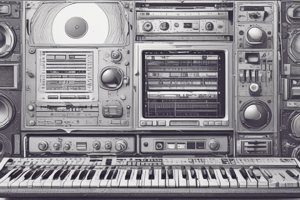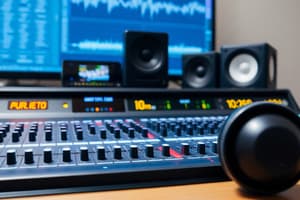Podcast
Questions and Answers
Which tool would you use to make selections in the Pro Tools session?
Which tool would you use to make selections in the Pro Tools session?
- Navigator
- Trim
- Grabber
- Selector (correct)
The Main Counter in Pro Tools can display values in Bars and Beats only.
The Main Counter in Pro Tools can display values in Bars and Beats only.
False (B)
What are the three primary editing tools in Pro Tools?
What are the three primary editing tools in Pro Tools?
Trim, Selector, Grabber
The playback cursor indicates the ___ in the Pro Tools session.
The playback cursor indicates the ___ in the Pro Tools session.
Match the following time scales with their descriptions:
Match the following time scales with their descriptions:
What would you find at the top of the Edit window in Pro Tools?
What would you find at the top of the Edit window in Pro Tools?
You can only navigate to specific points of the session's timeline using the mouse.
You can only navigate to specific points of the session's timeline using the mouse.
Which counter format would you use to see the location in Frames?
Which counter format would you use to see the location in Frames?
What color indicates that Relative Grid mode is active?
What color indicates that Relative Grid mode is active?
Spot mode allows users to type a specific location for clip placement.
Spot mode allows users to type a specific location for clip placement.
What is the shortcut key for activating Spot Mode?
What is the shortcut key for activating Spot Mode?
The Spot Dialog box uses the Time Scale pop-up menu to display time in a format called ______.
The Spot Dialog box uses the Time Scale pop-up menu to display time in a format called ______.
Match the Edit modes with their corresponding shortcut keys:
Match the Edit modes with their corresponding shortcut keys:
What happens when you drag a clip in Relative Grid mode?
What happens when you drag a clip in Relative Grid mode?
Repeatedly pressing the F4 key will only activate Absolute Grid mode.
Repeatedly pressing the F4 key will only activate Absolute Grid mode.
In the example given, where should the explosion sound effect be placed?
In the example given, where should the explosion sound effect be placed?
What does horizontal zooming allow you to do in the Edit window?
What does horizontal zooming allow you to do in the Edit window?
Using the scroll wheel while holding the Shift key allows you to scroll vertically.
Using the scroll wheel while holding the Shift key allows you to scroll vertically.
What key do you press to zoom in using keyboard shortcuts?
What key do you press to zoom in using keyboard shortcuts?
Vertical zooming does not change the ______ of your audio.
Vertical zooming does not change the ______ of your audio.
Match the following zooming methods with their descriptions:
Match the following zooming methods with their descriptions:
Which button is used to activate Edit Keyboard Focus?
Which button is used to activate Edit Keyboard Focus?
The Zoomer tool icon resembles a magnifying glass.
The Zoomer tool icon resembles a magnifying glass.
What features does the Audio Zoom In/Out button provide?
What features does the Audio Zoom In/Out button provide?
To scroll horizontally using a mouse scroll wheel, hold the ______ key.
To scroll horizontally using a mouse scroll wheel, hold the ______ key.
What is the result of incrementally clicking the Audio Zoom In button?
What is the result of incrementally clicking the Audio Zoom In button?
Clicking the bottom half of the Audio Zoom In/Out button will zoom up vertically.
Clicking the bottom half of the Audio Zoom In/Out button will zoom up vertically.
Which key is used to zoom out using keyboard shortcuts?
Which key is used to zoom out using keyboard shortcuts?
To zoom out using the scroll wheel, hold the ______ key while scrolling down.
To zoom out using the scroll wheel, hold the ______ key while scrolling down.
What effect does zooming in horizontally have on your Edit window?
What effect does zooming in horizontally have on your Edit window?
What happens when you change the Main Counter's time scale?
What happens when you change the Main Counter's time scale?
You can view only one time scale at a time in the Sub Counter.
You can view only one time scale at a time in the Sub Counter.
What method allows you to select a playback area by typing?
What method allows you to select a playback area by typing?
To move the playback cursor to the end of your timeline, hold the ______ key and press the Return key.
To move the playback cursor to the end of your timeline, hold the ______ key and press the Return key.
Match the shortcut keys with their corresponding actions:
Match the shortcut keys with their corresponding actions:
Which of the following can be used to navigate instantly to any location in your work?
Which of the following can be used to navigate instantly to any location in your work?
The Main and Sub Counters of the Edit window and Transport window are not linked.
The Main and Sub Counters of the Edit window and Transport window are not linked.
What occurs when you select an area on your timeline?
What occurs when you select an area on your timeline?
To confirm an entry in the Edit Selection Area, press ______ on Mac.
To confirm an entry in the Edit Selection Area, press ______ on Mac.
Match the playback selection methods with descriptions:
Match the playback selection methods with descriptions:
What does the Link Timeline and Edit Selection button do?
What does the Link Timeline and Edit Selection button do?
Dragging the blue arrow icons on a timeline allows you to adjust the selection area.
Dragging the blue arrow icons on a timeline allows you to adjust the selection area.
How can you confirm that the timeline and edit selections are linked?
How can you confirm that the timeline and edit selections are linked?
To select a playback area using the rulers, click and ______ horizontally.
To select a playback area using the rulers, click and ______ horizontally.
What color indicates that the Slip mode is active?
What color indicates that the Slip mode is active?
In Shuffle mode, dragging a clip onto an empty track will not snap it to the beginning of the timeline.
In Shuffle mode, dragging a clip onto an empty track will not snap it to the beginning of the timeline.
What is the purpose of Grid mode?
What is the purpose of Grid mode?
The Snap behavior in Shuffle mode ensures that there are no ______ between clips.
The Snap behavior in Shuffle mode ensures that there are no ______ between clips.
What happens when Loop Playback is activated?
What happens when Loop Playback is activated?
Match the edit modes with their correct descriptions:
Match the edit modes with their correct descriptions:
If the Insertion Follows Playback option is enabled, the playback cursor will return to its original position after playback stops.
If the Insertion Follows Playback option is enabled, the playback cursor will return to its original position after playback stops.
What is a key characteristic of Absolute Grid mode?
What is a key characteristic of Absolute Grid mode?
The Trim tool behaves the same in both Slip mode and Shuffle mode.
The Trim tool behaves the same in both Slip mode and Shuffle mode.
What are two ways to enable or disable Insertion Follows Playback?
What are two ways to enable or disable Insertion Follows Playback?
The Playback Cursor is also known as the __________.
The Playback Cursor is also known as the __________.
What happens when you drag a clip while in Shuffle mode?
What happens when you drag a clip while in Shuffle mode?
Match the following actions with their corresponding outcomes:
Match the following actions with their corresponding outcomes:
To activate Slip mode, click on the word ______ in the Edit window toolbar.
To activate Slip mode, click on the word ______ in the Edit window toolbar.
What visual indication appears when Loop Playback is active?
What visual indication appears when Loop Playback is active?
Match the following tools with how they behave in Slip mode:
Match the following tools with how they behave in Slip mode:
What is the advantage of using Relative Grid mode?
What is the advantage of using Relative Grid mode?
You can only scroll vertically in the Edit window of Pro Tools.
You can only scroll vertically in the Edit window of Pro Tools.
What shortcut key can you use to quickly toggle Insertion Follows Playback?
What shortcut key can you use to quickly toggle Insertion Follows Playback?
The Grid Value affects how clips snap when using Grid mode.
The Grid Value affects how clips snap when using Grid mode.
What is indicated by a red field in the Edit window toolbar?
What is indicated by a red field in the Edit window toolbar?
To find your playback cursor if it has moved off-screen, look for a __________ icon.
To find your playback cursor if it has moved off-screen, look for a __________ icon.
Using the Grabber tool in Absolute Grid mode allows you to snap your clip to the nearest ______.
Using the Grabber tool in Absolute Grid mode allows you to snap your clip to the nearest ______.
What effect does horizontal scrolling have in Pro Tools?
What effect does horizontal scrolling have in Pro Tools?
When scrolling vertically, you will see different tracks in the Edit window.
When scrolling vertically, you will see different tracks in the Edit window.
What happens to your selected area when you stop playback with Insertion Follows Playback enabled?
What happens to your selected area when you stop playback with Insertion Follows Playback enabled?
In Pro Tools, the playback will seamlessly start from the __________ of the selected area when Loop Playback is active.
In Pro Tools, the playback will seamlessly start from the __________ of the selected area when Loop Playback is active.
What does clicking and dragging the vertical scroll bar allow you to do?
What does clicking and dragging the vertical scroll bar allow you to do?
What happens when you double-click the Zoomer tool?
What happens when you double-click the Zoomer tool?
When 'No Scrolling' is selected, Pro Tools will automatically scroll when the playback cursor moves off the right edge of the Edit window.
When 'No Scrolling' is selected, Pro Tools will automatically scroll when the playback cursor moves off the right edge of the Edit window.
What is the primary function of the Trim tool in Pro Tools?
What is the primary function of the Trim tool in Pro Tools?
In Pro Tools, the playback cursor is indicated by a ______ vertical line in the edit window.
In Pro Tools, the playback cursor is indicated by a ______ vertical line in the edit window.
Match the following scrolling options with their descriptions:
Match the following scrolling options with their descriptions:
Which scrolling option allows the playback cursor to remain in the middle of the timeline?
Which scrolling option allows the playback cursor to remain in the middle of the timeline?
The Center Playhead scrolling option resets playback at the point where you stopped scrolling.
The Center Playhead scrolling option resets playback at the point where you stopped scrolling.
What is the effect of choosing the 'Page' scrolling option during playback?
What is the effect of choosing the 'Page' scrolling option during playback?
'Insertion Follows Playback' is usually ______ when using the 'No Scrolling' option.
'Insertion Follows Playback' is usually ______ when using the 'No Scrolling' option.
Match the editing tools to their functions:
Match the editing tools to their functions:
Which scrolling option allows you to see the playback cursor throughout the session?
Which scrolling option allows you to see the playback cursor throughout the session?
Pro Tools is a destructive editing platform, meaning audio data is permanently deleted when edited.
Pro Tools is a destructive editing platform, meaning audio data is permanently deleted when edited.
What is the key to activate the Trim tool in Pro Tools?
What is the key to activate the Trim tool in Pro Tools?
Continuous and Center Playhead scrolling options consume ______ of your computer's processing resources.
Continuous and Center Playhead scrolling options consume ______ of your computer's processing resources.
Which action does NOT describe the effect of using the Center Playhead scrolling option?
Which action does NOT describe the effect of using the Center Playhead scrolling option?
What is the primary function of the Trim tool?
What is the primary function of the Trim tool?
The Selector tool can be activated by pressing the F7 key.
The Selector tool can be activated by pressing the F7 key.
What happens when you double-click a clip with the Selector tool?
What happens when you double-click a clip with the Selector tool?
Using the Grabber tool, you can move clips by clicking and dragging them ____ or ____ in the timeline.
Using the Grabber tool, you can move clips by clicking and dragging them ____ or ____ in the timeline.
Match each tool with its primary function:
Match each tool with its primary function:
What combination of keys activates the Smart tool?
What combination of keys activates the Smart tool?
The Grabber tool allows you to select clips by double-clicking.
The Grabber tool allows you to select clips by double-clicking.
What will happen if you hold the Option key while moving a clip with the Grabber tool?
What will happen if you hold the Option key while moving a clip with the Grabber tool?
The large visual representation of sound is called a ____, which can be manipulated using various edit tools.
The large visual representation of sound is called a ____, which can be manipulated using various edit tools.
Match the editing tools with their assigned keyboard shortcuts:
Match the editing tools with their assigned keyboard shortcuts:
Which is NOT a primary edit tool in Pro Tools?
Which is NOT a primary edit tool in Pro Tools?
The Smart tool allows you to access the three primary edit tools based on cursor position.
The Smart tool allows you to access the three primary edit tools based on cursor position.
What is the standard Grabber tool more properly called?
What is the standard Grabber tool more properly called?
You can click and drag to select an area with the ____ tool.
You can click and drag to select an area with the ____ tool.
What does a triple-click in a track with the Selector tool do?
What does a triple-click in a track with the Selector tool do?
Flashcards
Main Counter
Main Counter
The main counter displays the time location of the playback cursor or selected region. It can be configured to show various time scales, including bars and beats, minutes and seconds, timecode, feet and frames, and samples.
Counters and Indicators
Counters and Indicators
The counters and indicators located at the top of the Edit window provide visual cues for the location of the timeline insertion point and the beginning of any selected area.
Playback Cursor
Playback Cursor
The playback cursor indicates the point where playback will begin, moving along the timeline as playback continues.
Main Counter Selector
Main Counter Selector
Signup and view all the flashcards
Edit Window
Edit Window
Signup and view all the flashcards
Scrolling Options
Scrolling Options
Signup and view all the flashcards
Primary Editing Tools
Primary Editing Tools
Signup and view all the flashcards
Edit Modes
Edit Modes
Signup and view all the flashcards
Loop Playback
Loop Playback
Signup and view all the flashcards
Timeline Selections
Timeline Selections
Signup and view all the flashcards
Insertion Follows Playback
Insertion Follows Playback
Signup and view all the flashcards
Insertion Follows Playback (Disabled)
Insertion Follows Playback (Disabled)
Signup and view all the flashcards
Playback Cursor Locator (Left)
Playback Cursor Locator (Left)
Signup and view all the flashcards
Playback Cursor Locator (Right)
Playback Cursor Locator (Right)
Signup and view all the flashcards
Horizontal Scrolling
Horizontal Scrolling
Signup and view all the flashcards
Vertical Scrolling
Vertical Scrolling
Signup and view all the flashcards
Sub Counter
Sub Counter
Signup and view all the flashcards
Selecting a Playback Point
Selecting a Playback Point
Signup and view all the flashcards
Selecting a Playback Area
Selecting a Playback Area
Signup and view all the flashcards
Go to Zero
Go to Zero
Signup and view all the flashcards
Go to End
Go to End
Signup and view all the flashcards
Edit Selection
Edit Selection
Signup and view all the flashcards
Link Timeline and Edit Selection
Link Timeline and Edit Selection
Signup and view all the flashcards
Changing Main Counter's Time Scale
Changing Main Counter's Time Scale
Signup and view all the flashcards
Mirroring Main and Sub Counter
Mirroring Main and Sub Counter
Signup and view all the flashcards
Typing a Location
Typing a Location
Signup and view all the flashcards
Using Rulers to Select a Playback Point
Using Rulers to Select a Playback Point
Signup and view all the flashcards
Typing a Playback Area
Typing a Playback Area
Signup and view all the flashcards
Using Rulers to Select a Playback Area
Using Rulers to Select a Playback Area
Signup and view all the flashcards
Absolute Grid Mode
Absolute Grid Mode
Signup and view all the flashcards
Relative Grid Mode
Relative Grid Mode
Signup and view all the flashcards
Spot Mode
Spot Mode
Signup and view all the flashcards
Spot Dialog Box
Spot Dialog Box
Signup and view all the flashcards
F Keys
F Keys
Signup and view all the flashcards
Shuffle Mode
Shuffle Mode
Signup and view all the flashcards
Slip Mode
Slip Mode
Signup and view all the flashcards
Edit Window Toolbar
Edit Window Toolbar
Signup and view all the flashcards
Horizontal Zooming
Horizontal Zooming
Signup and view all the flashcards
Smooth Zoom
Smooth Zoom
Signup and view all the flashcards
Vertical Zooming
Vertical Zooming
Signup and view all the flashcards
Zoomer Tool
Zoomer Tool
Signup and view all the flashcards
Edit Keyboard Focus
Edit Keyboard Focus
Signup and view all the flashcards
Activating Edit Keyboard Focus
Activating Edit Keyboard Focus
Signup and view all the flashcards
Scrolling with Scroll Wheel
Scrolling with Scroll Wheel
Signup and view all the flashcards
Zooming with Scroll Wheel
Zooming with Scroll Wheel
Signup and view all the flashcards
Zooming with Scroll Wheel
Zooming with Scroll Wheel
Signup and view all the flashcards
Vertical Zooming
Vertical Zooming
Signup and view all the flashcards
Audio Zoom
Audio Zoom
Signup and view all the flashcards
MIDI Zoom
MIDI Zoom
Signup and view all the flashcards
Miniature Zoom Tools
Miniature Zoom Tools
Signup and view all the flashcards
The Zoomer Tool
The Zoomer Tool
Signup and view all the flashcards
What is the Trim Tool?
What is the Trim Tool?
Signup and view all the flashcards
What does the Selector Tool do?
What does the Selector Tool do?
Signup and view all the flashcards
What's the purpose of the Grabber Tool?
What's the purpose of the Grabber Tool?
Signup and view all the flashcards
How do you remove a selected area with the Selector Tool?
How do you remove a selected area with the Selector Tool?
Signup and view all the flashcards
How do you select multiple clips?
How do you select multiple clips?
Signup and view all the flashcards
What is the 'Time Grabber'?
What is the 'Time Grabber'?
Signup and view all the flashcards
What does holding 'Option' or 'Alt' do while dragging?
What does holding 'Option' or 'Alt' do while dragging?
Signup and view all the flashcards
What is the 'Smart Tool'?
What is the 'Smart Tool'?
Signup and view all the flashcards
How does the 'Smart Tool' work?
How does the 'Smart Tool' work?
Signup and view all the flashcards
How can you activate the 'Smart Tool'?
How can you activate the 'Smart Tool'?
Signup and view all the flashcards
How does the 'Smart Tool' determine which tool is active?
How does the 'Smart Tool' determine which tool is active?
Signup and view all the flashcards
How do modifier keys work with the 'Smart Tool'?
How do modifier keys work with the 'Smart Tool'?
Signup and view all the flashcards
What is the 'Scrubber'?
What is the 'Scrubber'?
Signup and view all the flashcards
What's the "Pencil" tool used for?
What's the "Pencil" tool used for?
Signup and view all the flashcards
What's the benefit of using the 'Smart Tool'?
What's the benefit of using the 'Smart Tool'?
Signup and view all the flashcards
What is the benefit of using the Zoomer tool?
What is the benefit of using the Zoomer tool?
Signup and view all the flashcards
Describe the "No Scrolling" mode in Pro Tools.
Describe the "No Scrolling" mode in Pro Tools.
Signup and view all the flashcards
What is the difference between "No Scrolling" mode and "After Playback" mode?
What is the difference between "No Scrolling" mode and "After Playback" mode?
Signup and view all the flashcards
How does "Page" scrolling function in the Edit window?
How does "Page" scrolling function in the Edit window?
Signup and view all the flashcards
Explain what happens in Continuous scrolling mode.
Explain what happens in Continuous scrolling mode.
Signup and view all the flashcards
What is the key difference between Continuous and "Center Playhead" modes?
What is the key difference between Continuous and "Center Playhead" modes?
Signup and view all the flashcards
What is the main function of the Trim tool?
What is the main function of the Trim tool?
Signup and view all the flashcards
What is the purpose of the Grabber tool?
What is the purpose of the Grabber tool?
Signup and view all the flashcards
How can you quickly activate the Trim tool?
How can you quickly activate the Trim tool?
Signup and view all the flashcards
What does "non-destructive editing" in Pro Tools mean?
What does "non-destructive editing" in Pro Tools mean?
Signup and view all the flashcards
In what scenario would you use the Trim tool to remove material from an audio clip?
In what scenario would you use the Trim tool to remove material from an audio clip?
Signup and view all the flashcards
What is the advantage of non-destructive editing in Pro Tools?
What is the advantage of non-destructive editing in Pro Tools?
Signup and view all the flashcards
How do you prepare to trim a clip using the Trim tool?
How do you prepare to trim a clip using the Trim tool?
Signup and view all the flashcards
How do you trim an audio clip using the Trim tool?
How do you trim an audio clip using the Trim tool?
Signup and view all the flashcards
Trim Tool
Trim Tool
Signup and view all the flashcards
Selector Tool
Selector Tool
Signup and view all the flashcards
Grabber Tool
Grabber Tool
Signup and view all the flashcards
Grid Value
Grid Value
Signup and view all the flashcards
Edit Modes Display
Edit Modes Display
Signup and view all the flashcards
Timeline Items
Timeline Items
Signup and view all the flashcards
Yellow Line
Yellow Line
Signup and view all the flashcards
Study Notes
Pro Tools Editing Fundamentals
-
Pro Tools editing involves navigating the timeline and using editing tools.
-
Navigation tools allow quick selection and playback control.
-
Counters and rulers locate time positions on the timeline.
-
Main counter displays time (bars/beats, minutes/seconds, timecode, feet/frames, samples)
- Changing the main counter time scale changes the Edit Selection timescale and possibly displays the corresponding ruler.
-
Sub counter displays a secondary timescale.
-
-
Typing a value (in Main or Sub counter) moves the playback cursor.
-
Clicking a timecode ruler moves the cursor to that point.
-
Selecting a playback area (start, end, length) sets a playback range (selecting a ruler range also does this).
-
Short-cuts: Pressing Return (Mac) / Enter (Win) moves to start; Option + Return (Mac) / Alt + Enter (Win) moves to end.
-
Shift + Return / Enter selects to session start.
-
Shift + Option + Return/Enter selects to session end.
-
Link Timeline and Edit Selection (Options menu or toolbar button): Matches timeline selection with track selections.
Playback Cursor
-
Playback cursor (timeline insertion): Shows your position on the timeline.
-
Insertion Follows Playback:
- Disabled: Playback cursor to its original position. Playback starts from the beginning.
- Enabled: Playback cursor stays at playback end point. Playback restarts where it previously left off.
-
Playback Cursor Locator icons (left/right triangle) indicate cursor off-screen.
-
Using left/right arrow keys scrolls to the the cursor's location.
Scrolling and Zooming
-
Horizontal and vertical scrolling navigate in the Edit window.
-
Scroll wheel with modifier key(Shift) scrolls horizontally.
-
Zoom changes the view's time representation and audio details.
- Zoom buttons (left/right arrow): Increase/decrease horizontal zoom
- Scroll wheel with modifier key(Option/Alt) zooms horizontally.
-
Zoom controls (minus/plus): Zoom in/out (horizontal or vertical).
-
F1+F2,F3,F4 to quickly shift between the various modes.
-
The Edit Keyboard Focus enables specific F key combinations.
Edit Tools: Trim, Selector, and Grabber
-
Trim tool: Adjusts clip boundaries.
-
Selector tool: Selects areas on tracks or rulers.
- Selecting using double clicks or triple clicks.
-
Grabber tool: Moves clips within the session or to other tracks.
- Copies clip by holding Option/Alt.
-
(Other edit tools Scrubber and Pencil) - refer to included addendum for this information.
Edit Modes
-
Shuffle mode: arranges clips to align end-to-end.
- Clips add to/move to the end of clips.
-
Slip mode: Enables flexible manipulation of clip position and length.
-
Spot mode: Allows exact positioning clips by typing in times or using specific dialog boxes.
-
Grid mode: (Absolute Grid, Relative Grid): Clips snap to grid lines.
- Absolute: Snap clips to nearest grid line
- Relative: Clips move at specified intervals from the nearest grid line.
Quick Access Edit-mode shortcuts
- F1=Shuffle, F2=Slip, F3=Spot, F4=Grid -(Repeated for F4 to toggle between Absolute/Relative Grid)
Studying That Suits You
Use AI to generate personalized quizzes and flashcards to suit your learning preferences.




